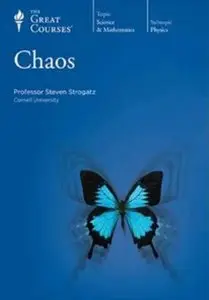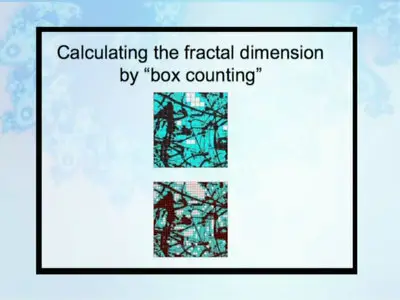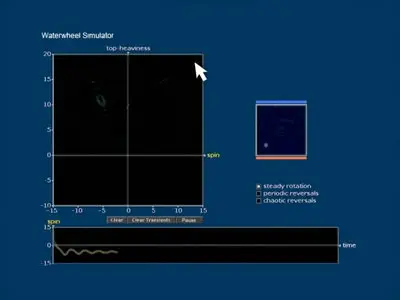Chaos
24xDVDRip | AVI/XviD, ~743 kb/s | 640x480 | Duration: 12:17:33 | English: MP3, 128 kb/s (2 ch) | + PDF Guide | 4.43 GB
Genre: Science
24xDVDRip | AVI/XviD, ~743 kb/s | 640x480 | Duration: 12:17:33 | English: MP3, 128 kb/s (2 ch) | + PDF Guide | 4.43 GB
Genre: Science
It has been called the third great revolution of 20th-century physics, after relativity and quantum theory. But how can something called chaos theory help you understand an orderly world? What practical things might it be good for? What, in fact, is chaos theory? "Chaos theory," according to Dr. Steven Strogatz, Director of the Center for Applied Mathematics at Cornell University, "is the science of how things change." It describes the behavior of any system whose state evolves over time and whose behavior is sensitive to small changes in its initial conditions.
The 24 lectures of Chaos take you to the heart of chaos theory as it is understood today. Taught by Professor Strogatz, an award-winning Ivy League professor and a scientist described by Nature magazine as "one of the most creative biomathematicians of the past few decades," Chaos introduces you to a fascinating discipline that has more to do with your everyday life than you may realize.
A Revolutionary Way of Thinking
Surprisingly, you have already encountered chaos theory before, although you might not have recognized it at the time. From the flapping of a butterfly's wings to the dripping of a leaky faucet, chaos theory draws a wealth of unordinary insight from the most ordinary of occurrences.
Chaos theory affects nearly every field of human knowledge and endeavor, from astronomy and zoology to the arts, the humanities, and business. It can:
help analysts understand price fluctuations in the stock market,
ensure a smooth flow of data traffic on the Internet, and
show insurance companies how to manage the risks of natural catastrophes.
This course shows you the importance of this revolutionary field and how it has helped us come closer than ever to solving some of life's mysteries. Today, the underlying mathematics of science's major unsolved problems—including the nature of consciousness, the origin of life, and cancer—are essentially nonlinear; express any of these problems as a mathematical system and you learn that the whole may be either more or less than the sum of its parts.
In its ability to tackle bewilderingly complex problems, chaos theory has revolutionized the way we perceive the world around us. It allows scientists to reach beyond a dependency on the analytical limitations of the deterministic, "clockwork" universe that was the legacy of thinkers like Galileo, Kepler, and especially Newton.
Throughout the lectures, Professor Strogatz makes the case for why chaos theory marks such a radical departure from traditional science:
It asks unusual questions at the everyday scale of human life.
It shifts the focus off the laws of nature and onto their consequences.
It uses the computer not as a calculating tool but as a means of amplifying intuition.
It does not reduce complex problems into their separate parts but puts the parts back together to help understand the whole.
It is radically interdisciplinary in an era of increasingly specialized disciplines.
It paints a topsy-turvy picture of the world in which simple systems can show complex behavior.
It is a scientific field in which change came about suddenly.
Follow the Exciting Story of Chaos
As you delve into this ever-evolving field, you learn the surprising tale of how chaos theory was discovered—a story that Professor Strogatz likens to a detective novel filled with twists and turns.
First glimpsed by the French mathematician Henri Poincaré, the notion of chaos theory was lost for nearly a century before being rediscovered—almost accidentally. It was revived by a mathematically oriented meteorologist named Edward Lorenz, whose development of the butterfly effect (the extreme sensitivity of a chaotic system to tiny changes in its initial conditions) had little impact until the 1970s and 1980s, when the wave of chaos theory finally crashed onto the shores of the scientific community.
As you follow the story of chaos theory's development, you approach the core ideas of chaos in the same way the world's greatest thinkers, grounded in their historical contexts, once did. This story not only helps you understand the fundamentals of this field, but it also helps you appreciate the extraordinary intellectual feat that chaos theory represents.
Learn Chaos Theory Visually
This course offers you a unique opportunity to get an expert's instruction on the field of chaos theory and is one of the only places outside the halls of academia where you can follow along with detailed computer graphics—specifically developed for this course—as visual aids.
"For understanding these core concepts [of chaos theory], pictures turn out to be much more powerful than formulas," notes Professor Strogatz. Forgoing a heavy reliance on advanced math, he uses clear and powerful computer graphics to clarify chaos theory's core concepts.
A large portion of the course explores the intimate relationship between chaos theory and fractals: shapes or processes whose structures repeat ad infinitum such that the tiniest parts resemble the original whole. You see how fractals are unique from more commonly known shapes like circles and cubes and how they can be used to describe a variety of processes and phenomena like the jagged coastline of Norway or the drip paintings of Jackson Pollock.
Find the Unordinary in the Ordinary
Professor Strogatz's expert guidance lays bare the complexities of chaos theory in a way that any interested layperson can understand. With the insights he provides in Chaos, news stories about key scientific discoveries and new directions in research take on a fresh importance.
Professor Strogatz is a teacher repeatedly honored by institutions and students alike. During his tenure at the Massachusetts Institute of Technology, he received the E. M. Baker Memorial Award for Excellence in Undergraduate Teaching, the university's only institute-wide teaching prize selected and awarded solely by students. In 2007, he received a lifetime achievement award for the communication of mathematics to the general public from the Joint Policy Board for Mathematics, which represents the four major American mathematical societies.
Whether charting the exciting history of the field, focusing on fractals as "the footprints of chaos," or journeying to the frontiers of chaos research, this course shows you new ways to think about and view the world around you.
Lectures:
1. The Chaos Revolution
2. The Clockwork Universe
3. From Clockwork to Chaos
4. Chaos Found and Lost Again
5. The Return of Chaos
6. Chaos as Disorder—The Butterfly Effect
7. Picturing Chaos as Order—Strange Attractors
8. Animating Chaos as Order—Iterated Maps
9. How Systems Turn Chaotic
10. Displaying How Systems Turn Chaotic
11. Universal Features of the Route to Chaos
12. Experimental Tests of the New Theory
13. Fractals—The Geometry of Chaos
14. The Properties of Fractals
15. A New Concept of Dimension
16. Fractals Around Us
17. Fractals Inside Us
18. Fractal Art
19. Embracing Chaos—From Tao to Space Travel
20. Cloaking Messages with Chaos
21. Chaos in Health and Disease
22. Quantum Chaos
23. Synchronization
24. The Future of Science
Welcome to the best eLearning video (English, German, French, Spanish language) and many more: LINK
Do not forget to check my blog! Updated regularly!
Do not forget to check my blog! Updated regularly!
No mirrors pls!











